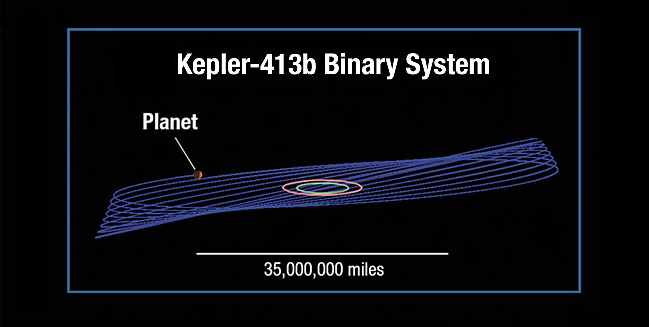
Observations made by the Kepler spacecraft have shown that Kepler-413b is a very wobbling exoplanet. The planet's orbit is unusual in that it is tilted 2.5 degrees with respect to the plane of the binary star's orbit.
Over an 11-year period, the planet's orbit too would appear to wobble as it circles around the star pair. That kind of behaviour of transiting circumbinary planets (planet that orbits two stars) or CBP was first predicted in 1994 by Jean Schneider. He detailed his predictions in "On the occultations of a binary star by a circum-orbiting dark companion". Kepler-413b is the newest example, but there are more circumbinary planets behaving that way.
"Two other circumbinary planets have similar behavior, albeit not quite drastic over the course of the observations." Veselin Kostov of the Space Telescope Science Institute (STScI) told astrowatch.net.
Over an 11-year period, the planet's orbit too would appear to wobble as it circles around the star pair. That kind of behaviour of transiting circumbinary planets (planet that orbits two stars) or CBP was first predicted in 1994 by Jean Schneider. He detailed his predictions in "On the occultations of a binary star by a circum-orbiting dark companion". Kepler-413b is the newest example, but there are more circumbinary planets behaving that way.
"Two other circumbinary planets have similar behavior, albeit not quite drastic over the course of the observations." Veselin Kostov of the Space Telescope Science Institute (STScI) told astrowatch.net.
"Kepler-16b will stop transiting the primary star in 2018 and the secondary star in 2014" Kostov said. After that, the planet will remain undetectable using the transit method until around 2042. Kepler-16b is a Saturn-mass planet consisting of half gas and half rock and ice, and it orbits a binary star, Kepler-16, with a period of 229 days.
It is the first confirmed, unambiguous example of a CBP.
It is the first confirmed, unambiguous example of a CBP.
Another example is a gas giant that orbits the two stars in the Kepler-35 system. The planet Kepler-35b is over an eighth of Jupiter's mass and completes a somewhat eccentric orbit every 131.458 days from a semimajor axis of just over 0.6 AU, only about 3.5 times the semi-major axis between the parent stars.
The proximity and eccentricity of the binary star as well as both stars have similar masses results the planet's orbit to significantly deviate from Keplerian orbit. Studies have suggested that this planet must have been formed outside its current orbit and migrated inwards later. According to Kostov, Kepler-35b already stopped transiting and will start again in a decade.
The proximity and eccentricity of the binary star as well as both stars have similar masses results the planet's orbit to significantly deviate from Keplerian orbit. Studies have suggested that this planet must have been formed outside its current orbit and migrated inwards later. According to Kostov, Kepler-35b already stopped transiting and will start again in a decade.
Why those planets are out of alignment with their stars? What is the most probable cause of it? "This is a tough one. Note that the Kepler-413b misalignment is small (~2.5 degrees, smaller than Mercury's) and is not unique amongst the known transiting CBPs. Kepler-64b, for example, has a similar misalignment, but the primary star there is a lot bigger so the planetary transits are consecutive in the data." Kostov explains. "There could be other planets in the system, or a more distant stellar companion."
The next transit of Kepler-413b is not predicted to occur until 2020. This is due not only to the orbital wobble, but also to the small diameters of the stars and the fact that the orbital plane of the stars is not exactly edge-on to our line of sight. It just so happened that the astronomers caught the planet while it was transiting. "I do plan to come back to this system in 2020 and see if our prediction for the next transit is correct." Kostov said.
Because of the orbital wobble, the orbit continuously moves up or down relative to our view. This change is large enough that sometimes it misses passing in front of the stars, as seen from Earth.





Comments